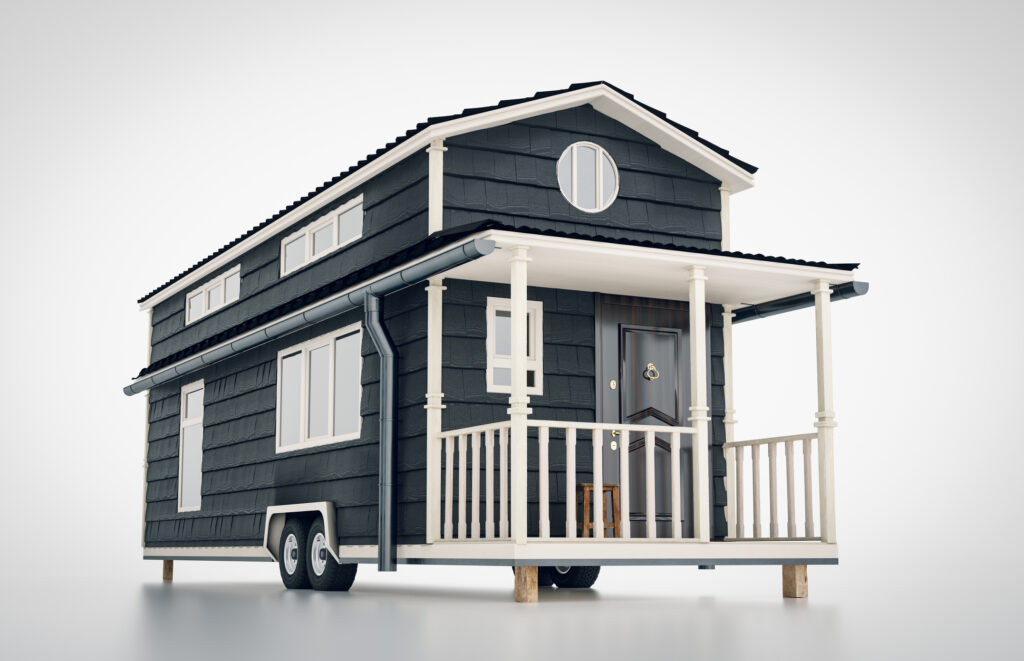
In an effort to address housing affordability, state lawmakers from around the country are looking to take action on both Accessory Dwelling Units and “Tiny Homes.” These measures are seen as innovative solutions to provide more affordable housing options, increase potential income for homeowners, and enhance family support structures.
According to the American Planning Association, an Accessory Dwelling Unit (ADU) is a smaller, independent residential dwelling situated on the same property as a detached single-family home. Known by various names such as accessory apartments, secondary suites, and granny flats, ADUs can take several forms: converted parts of existing homes (internal ADUs), additions to homes (attached ADUs), or new or converted stand-alone structures (detached ADUs).
Unlike ADUs, which are built on the same property as an existing home, tiny homes have two distinct construction types: they can either be built on wheels (mobile) or on foundations. Notably, however, tiny homes are not built on the same plot as an existing home.
Colorado ADU Bill Signed Into Law
In May 2024, Governor Jared Polis (D) signed legislation into law allowing residents to build ADUs on their property, with a goal of creating some more affordable housing options for Coloradans.
The bill mandates that subject jurisdictions must allow, through an administrative approval process, the addition of one ADU as an accessory use to a single-unit detached dwelling in any area where such dwellings are permitted. It also prohibits subject jurisdictions from enacting or enforcing local laws that would restrict the construction or conversion of ADUs.
According to a press release sent out by the governor when he signed the bill, the new law empowers homeowners to build ADUs, also known as ‘casitas’, on their property without incurring costly paperwork and delays. The goal of the newly enacted law is to create more affordable housing opportunities, provide homeowners with potential additional income, and offer living spaces for younger or older family members, enhancing family cohesion and support.
Florida Movable Tiny Home Legislation
Florida’s building code defines a “tiny house” as a dwelling 400 square feet or less in floor area, excluding lofts. Legislation introduced by lawmakers in January 2024 calls for allowing movable tiny homes to be utilized for year-round living, which is currently limited to seasonal use. The bill redefines “trailer” to include “movable tiny homes,” broadening the scope of housing options.
A “movable tiny home” is specified as a transportable unit mounted on a single chassis, designed for permanent living for one household, and with a maximum width of 14 feet and a total area under 500 square feet when set up. These homes must be connected to necessary utilities, built, and inspected according to the Building Code, and certified by a licensed professional engineer, architect, or third-party inspector for compliance. This inclusion aims to provide more flexible and affordable housing solutions.
The bill died in the House Commerce Committee in the 2024 legislative session.
Hawaii Bill to Provide Financing for Developing Accessory Dwelling Units
Legislation in Hawaii would establish the Accessory Dwelling Unit Loan Program and Accessory Dwelling Unit Loan Revolving Fund. The bill’s committee report notes that the state is facing a housing shortage, and constructing ADUs is part of the solution to address the housing shortage. The report further notes that traditional financing for ADUs may be difficult to secure, an obstacle which the establishment of the loan program seeks to overcome.
The revolving loan fund would be able to receive funding from legislative appropriations, private contributions, loan repayments, interest, program fees, and other sources. Its primary purpose would be to finance the construction and conversion of accessory dwelling units (ADUs) through loans provided to non-depository community development financial institutions, which in turn lend to eligible borrowers. Additionally, the fund offers technical assistance grants up to $200,000 to these financial institutions, requiring a 20% match of grant funds, with 10% dedicated to marketing and outreach. Each grant would be disbursed over a three-year period.
Massachusetts Bills on Movable Tiny Houses
Legislation introduced (S. 897 and H. 1359) by Massachusetts lawmakers would add a definition of “movable tiny house” to state law, defined as transportable dwelling units built on a frame or chassis with no more than 400 square feet, excluding certain features. These tiny houses are intended for residential use on individual house lots where single-family dwellings are allowed or as accessory dwelling units. Under the legislation, they must be permanently affixed to a chassis approved by the Massachusetts Department of Transportation (MassDOT) and conform to state building code regulations, with specified insulation requirements.
The legislation further mandates that the MassDOT, Registry of Motor Vehicles, and Secretary of the Commonwealth establish a new category for movable tiny houses, including a process for applying for, issuing, and canceling certificates of title.
The legislation also allows cities and towns to adopt less restrictive regulations than those outlined in the bills, ensuring that design criteria do not exclude movable tiny houses. Lastly, municipalities, under the bills, may offer tax abatements or other incentives to encourage hosted parking of these tiny homes. This legislative change aims to promote flexible, affordable, and sustainable housing options within the state.
Both bills are still pending as of June 5, 2024.
New Jersey Bill to Create Tiny Home Pilot Program
Legislation was introduced in both the Senate and Assembly in January 2024 to establish a “Sustainable Tiny Home Pilot Program.” The goal of the bill is to combat climate change and reduce New Jersey’s carbon footprint by constructing small and environmentally friendly homes.
The legislation would require the Executive Director of the Housing and Mortgage Finance Agency to select municipalities from three state regions for a pilot program focused on constructing tiny homes. These homes, limited to 300 square feet of interior space, will be built according to green building standards set in collaboration with the Commissioners of Community Affairs and Environmental Protection. The initiative will offer grants to builders, making tiny homes a permitted use in all residential districts of the selected municipalities.
The bill allocates $5 million from the general fund, with $1.65 million distributed annually over three years to support qualified builders in developing tiny home communities. An annual report on the program’s progress in reducing the state’s carbon footprint and combating global warming is required under the legislation.
According to the bill’s statement, an average house contributes 28,000 pounds of CO2 annually, compared to a tiny home’s 2,000 pounds.
As of June 5, 2024, neither bill has advanced beyond its committee of origination.
Vermont Bill on Tiny Home Zoning
Vermont lawmakers introduced H. 540 in January 2024. The proposed bill aims to adjust municipal zoning laws to permit the construction or placement of tiny houses on lots of one or more acres as a permitted use. Specifically, it allows for one tiny house per acre, and two tiny houses on lots of two or more acres. Additionally, if a single-family home already exists on the lot, the tiny house does not need its own wastewater capacity, provided the occupant of the tiny house is related to the occupant of the single-family home.
This change in zoning regulations seeks to promote flexible and affordable housing solutions, fostering family proximity and supporting the tiny house movement. However, the bill did not advance in the 2024 legislative session.
From The Experts
Expert insights from the authors at Duane Morris Government Strategies.
Ryan Stevens
Policy experts suggest that ADU and tiny home legislation could significantly impact housing affordability and availability, providing flexible solutions for homeowners and municipalities alike.
Latest News
Photo credit: iStock.com/Valentyna Yeltsova Increasing affordable housing shortages have led state policymakers to focus on how to best to tackle the issue, something we noted in our recent article examining ADU and tiny home legislation. [...]
Photo credit: iStock.com/pcess609 In December 2022, a survey found that 582,462 people in the United States were experiencing homelessness. This survey showed an increase in 2,000 individuals since the survey was last conducted in [...]
Photo credit: iStock.com/MattGush In the United States, over half-a-million people are experiencing homelessness on any given night. Homelessness is not a new issue, but it has increased over 2022 as the number of Americans living [...]
Photo credit: iStock.com/mohd izzuan The high fluctuations within the housing market have recently encouraged buyers and renters to rethink their moving plans. Many depending on affordable housing units have experienced the trickledown effect of this [...]






Stay In Touch